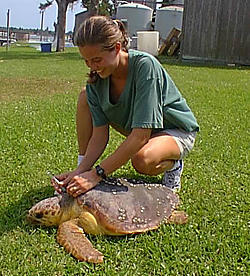The same chemicals that keep food from sticking to our frying pans and stains from setting in our carpets are damaging the livers and impairing the immune systems of loggerhead turtles—an environmental health impact that also may signal a danger for humans.

Keller said that in a 2005 study,* PFC concentrations measured in the plasma of turtles found along the coast from Florida to North Carolina indicated that PFCs have become a major contaminant for the species. The levels of the most common PFC, perfluorooctane sulfonate (PFOS), were higher in turtles captured in the north than in the south. Data recently evaluated by NIST and College of Charleston graduate student Steven O'Connell shows that this northern trend of higher PFOS concentrations continues up into the Chesapeake Bay.
Blood chemistry analyses of PFC-contaminated loggerheads suggested damage to liver cells and the suppression of at least one immune function which could lead to a higher risk of disease. To support the "cause-effect relationship" between PFCs and illness, the researchers exposed Western fence lizards to the same PFOS levels found in loggerheads in the wild. The lizards showed significant increases in an enzyme that indicates liver toxicity. They also had signs of suppressed immune function.
These findings, Keller said, indicate that current environmental PFC exposures—at concentrations comparable to those seen in human blood samples—are putting marine species at enhanced risk of health problems from reduced immunity and may suggest a similar threat to us.
Keller reported that a recently completed study** led by colleague Margie Peden-Adams of the Medical University of South Carolina that showed PFOS is toxic to the immune systems of mice at concentrations found both in loggerhead sea turtles and humans. The ability of the mouse immune system to respond to a challenge was reduced in half by PFOS—and this occurred at the lowest level of the compound ever reported for a toxic effect.
If our immune systems have a similar sensitivity to PFOS, Keller explained, humans could be immunocompromised from current environmental exposure to PFOS.
* J. M. Keller, K. Kannan, S. Taniyasu, N. Yamashita, R.D. Day, M.D. Arendt, A.L. Segars and J. R. Kucklick. Perfluorinated compounds in the plasma of loggerhead and Kemp's Ridley sea turtles from the southeastern coast of the U.S. Environmental Science and Technology, Vol. 39, pp. 9101-9108 (2005).
** M.M. Peden-Adams, J.M. Keller, J.G. EuDaly, J. Berger, G.S. Gilkeson and D.E. Keil. Suppression of humoral immunity in mice following exposure to perfluorooctane sulfonate (PFOS). Submitted for publication.

